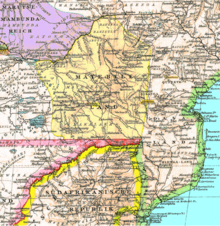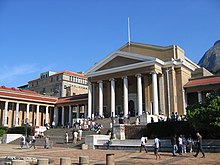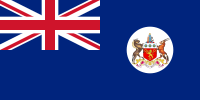Leander Starr Jameson
A major contributor to this article appears to have a close connection with its subject. (January 2023) |
Administrator of Southern Rhodesia | |
|---|---|
| In office 10 September 1894 – 2 April 1896 | |
| Monarch | Queen Victoria |
| Preceded by | A. R. Colquhoun |
| Succeeded by | The Earl Grey |
| 2nd Chief Magistrate of Southern Rhodesia | |
| In office 18 September 1891 – 7 October 1893 | |
| Monarch | Queen Victoria |
| Preceded by | A. R. Colquhoun |
| Succeeded by | A. H. F. Duncan |
| Personal details | |
| Born | Leander Starr Jameson 9 February 1853 Matopos Hills, Rhodesia |
| Nationality | British |
| Political party | Progressive Party |
| Alma mater | University College London |
| Occupation | Physician |
Sir Leander Starr Jameson, 1st Baronet
Early life and family
This section needs additional citations for verification. (January 2023) |
He was born on 9 February 1853, the youngest of 12 children of
Leander Starr Jameson was born at
Leander was educated for the medical profession at
Jameson was for some time the
Character
Longford wrote that Rudyard Kipling wrote the poem "If—" with Leander Starr Jameson in mind as an inspiration for the characteristics he recommended young people to live by (notably Kipling's son, to whom the poem is addressed in the last lines). Longford writes, "Jameson was later to be the inspiration and hero of Rudyard Kipling's poem, If...".[5] Direct evidence that the poem "If—" was written about Jameson is available also in Rudyard Kipling's autobiography in which Kipling writes that "If—" was "drawn from Jameson's character."[6][7]
In 1895, Jameson led about 500 of his countrymen in what became known as the
Seymour Fort 1918 wrote of L.S. Jameson in this way:
... It was not his wont to talk at length, nor was he, unless exceptionally interested, a good listener. He was so logical and so quick to grasp a situation, that he would often cut short exposition by some forcible remark or personal raillery that would all too often quite disconcert the speaker.
Despite his adventurous career, mere reminiscences obviously bored him; he was always for movement, for some betterment of present or future conditions, and in discussion he was a master of the art of persuasion, unconsciously creating in those around him a latent desire to follow, if he would lead. The source of such persuasive influence eludes analysis, and, like the mystery of leadership, is probably more psychic than mental. In this latter respect, Jameson was splendidly equipped; he had greater power of concentration, of logical reasoning, and of rapid diagnosis, while on his lighter side he was brilliant in repartee and in the exercise of a badinage that was both cynical and personal...
... He wrapped himself in cynicism as with a cloak, not only to protect himself against his own quick human sympathy, but to conceal the austere standard of duty and honour that he always set to himself. He was ever trying to hide from his friends his real attitude towards life, and the high estimate he placed upon accepted ethical values... He was essentially a patriot who sought for himself neither wealth, nor power, nor fame, nor leisure, nor even an easy anchorage for reflection. The wide sphere of his work and achievements, and the accepted dominion of his personality and his influence were both based upon his adherence to the principle of always subordinating personal considerations to the work in hand, upon the loyalty of his service to big ideals. His whole life seems to illustrate the truth of the saying that in self-regard and self-centredness there is no profit, and that only in sacrificing himself for impersonal aims can a man save his soul and benefit his fellow men.[8]
A less flattering view is given in Antony Thomas's Rhodes (1996), in which Jameson is portrayed as unscrupulous.
The Jameson Raid


In 1895, Jameson assembled a private army outside the
In November 1895, a piece of territory of strategic importance, the Pitsani Strip, part of the
Rhodes hoped that the intervention of the company's private army could spark an Uitlander uprising, leading to the overthrow of the Transvaal government. Rhodes' forces were assembled in the Pitsani Strip for this purpose. Joseph Chamberlain informed Salisbury on Boxing Day that an uprising was expected, and was aware that an invasion would be launched, but was not sure when. The subsequent Jameson Raid was a debacle, leading to the invading force's surrender. Chamberlain, at Highbury Hall, his home in Birmingham, received a secret telegram from the Colonial Office on 31 December informing him of the beginning of the Raid.
Though sympathetic to the ultimate goals of the Raid, Chamberlain was uncomfortable with the timing of the invasion[why?] and remarked "if this succeeds it will ruin me. I'm going up to London to crush it". He swiftly travelled by train to the Colonial Office, ordering Sir Hercules Robinson, Governor of the Cape Colony, to repudiate the actions of Jameson and warned Rhodes that the company's Charter would be in danger if it were discovered that the Cape Prime Minister were involved in the Raid. The prisoners were returned to London for trial, and the Transvaal government received considerable compensation from the company. Jameson was tried in England for leading the raid; during that time he was lionised by the press and London society.
The Jameson Raid trial
The Jameson Raiders arrived in England at the end of February, 1896 to face prosecution under the Foreign Enlistment Act 1870 styled R. v Jameson, Willoughby and others.[9] There were some months of investigations initially held at Bow Street Magistrates' Court, following which the trial at bar (a trial in front of multiple judges instead of a jury) began on 20 June 1896, at the High Court. The trial lasted seven days, following which Dr Jameson was "found guilty and sentenced to imprisonment as a first-class misdemeanant for fifteen months.[2] He was, however, released from Holloway in the following December on account of illness."[8]
During the trial of Jameson, Rhodes' solicitor,
The conduct of Dr Jameson during the trial was graphically described by Krout 1899, an eyewitness account of her observations during the Jameson Raid trial. She wrote:
.... Dr. Jameson was very grave and he, alone, was somewhat ill at ease. As he entered the court room a dark flush mounted to his forehead, which slowly faded as he walked to his chair and seated himself with great deliberateness. He was a man somewhat below medium height, with a huge head carried a little to one side, showing a remarkable breadth of brow; the eyes were large, dark and sufficiently expressive, when not concealed by the heavy drooping lids that were frequently half, or wholly, closed; the nose was prominent and large and rather symmetrical, the chin and mouth indicated decided firmness; the whole expression and demeanour of the man evinced fearlessness that would be disposed to express itself in deeds rather than words. He, too, was carefully dressed in a dark frock coat and trousers, a spotless, white necktie and pale grey gloves-the conventional morning dress of an English gentleman. He walked with a heavy un-elastic tread and a slightly swinging carriage, and sat much of the time obliquely in his chair, one cheek resting upon his elegantly gloved hand; his glance was often cast down or fixed at rare intervals upon his counsel,
Mary Krout[10]
Jameson was sentenced to fifteen months in gaol, but was soon pardoned.[2] In June 1896, Chamberlain, British Colonial Secretary of the day, offered his resignation to Lord Salisbury, having shown the Prime Minister one or more of the cablegrams implicating him in the Raid's planning. Salisbury refused to accept the offer, possibly reluctant to lose the government's most popular figure. Salisbury reacted aggressively in support of Chamberlain, supporting the Colonial Secretary's threat to withdraw the company's charter if the cablegrams were revealed. Accordingly, Rhodes refused to reveal the cablegrams, and as no evidence was produced showing that Chamberlain was complicit in the Raid's planning, the Select Committee appointed to investigate the events surrounding the Raid had no choice but to absolve Chamberlain of all responsibility.[citation needed]
Jameson had been Administrator General for Matabeleland at the time of the Raid and his intrusion into Transvaal depleted Matabeleland of many of its troops and left the whole territory vulnerable. Seizing on this weakness, and a discontent with the
Later political career
Despite the Raid, Jameson had a successful political life following the invasion, receiving many honours in later life. In 1903, Jameson was put forward as the leader of the
During the
Honours
Leander Starr Jameson was awarded the:
- KCMG
- CB
- Freedom of the City of London for services to the British Empire
- Freedom of the City of Manchester for services to the British Empire
- Freedom of the City of Edinburgh for services to the British Empire
Jameson was created a
Death
Sir Leander Starr Jameson, 1st Bt., died on the afternoon of Monday, 26 November 1917, at his home, 2 Great Cumberland Place, Hyde Park, in London. His body was laid in a vault at Kensal Green Cemetery on 29 November 1917, where it remained until 1920 when it was exhumed and reburied alongside Cecil Rhodes at Malindidzimu Hill,[13] a granite hill in the Matobo National Park, 40 kilometres (25 mi) south of Bulawayo. It was designated by Cecil Rhodes as the resting place for those who served Great Britain well in Africa.
Biographies, portraits and honours

Jameson's life is the subject of a number of biographies, including The Life of Jameson by Ian Colvin (1922, Vol. 1 and 1923, Vol. 2), Dr. Jameson by G. Seymour Fort (1918), and The If Man by Chris Ash (2012). The Jameson Raid has been the subject of numerous articles and books, and remains a fascinating historical riddle more than one hundred years after the events of the Raid took place.
There are three portraits of Jameson in the
During the colonial period, the Zambian town of Chipata was named "Fort Jameson" in Jameson's honour.
Later historical documents
In 2002, The Van Riebeck Society published Sir Graham Bower’s Secret History of the Jameson Raid and the South African Crisis, 1895–1902,
References
Citations
- ^ Banerji.
- ^ a b c d e f g Chisholm 1911.
- ^ Seymour Fort 1918, p. 53.
- ^ Longford 1982.
- ^ Longford 1982, p. 44.
- ^ Kipling 1937, p. 191.
- ^ Ash 2012.
- ^ a b Seymour Fort 1918, pp. 331–335.
- ^ The National Archives: "Queen's Bench: R v Leander Starr Jameson, Sir John Christopher Willoughby Bt, Henry..." TS 36/102
- ^ Krout 1899.
- ^ McCracken 1967, p. 52.
- ^ Chronicle of 20th Century History edited by J S Bowman; ISBN 1-85422-005-5
- ^ Wells 1956, p. 191.
- ^ Bower 2002.
- ^ Cousins 2004.
Sources
- Ash, Chris (2012). The If Man: Dr Leander Starr Jameson, the Inspiration for Kipling's Masterpiece. Helion & Company. ISBN 978-1-920143-58-9.
- Banerji, Nilanjana. "Jameson, Robert William (1805–1868)". doi:10.1093/ref:odnb/14634. (Subscription or UK public library membershiprequired.)
- Bower, Graham (2002). Deryck Marshall Schreuder; Jeffrey Butler (eds.). Sir Graham Bower's Secret History of the Jameson Raid and the South African Crisis, 1895-1902. The Van Riebeeck Society. ISBN 978-0-9584112-9-5.
- This article incorporates text from a publication now in the public domain: Chisholm, Hugh, ed. (1911). "Jameson, Leander Starr". Encyclopædia Britannica. Vol. 15 (11th ed.). Cambridge University Press. pp. 147–148.
- Colvin, Ian Duncan (1922). The Life of Jameson. Vol. 1. London: Edward Arnold.
- Colvin, Ian Duncan (1923). The Life of Jameson. Vol. 2. London: Edward Arnold.
- Cousins, A. (2004). "Review of Deryck Schreuder and Jeffrey Butler, 'Sir Graham Bower's Secret History of the Jameson Raid and the South African Crisis, 1895–1902'". History. 89 (295). Blackwell: 434–448. ISSN 0018-2648.
- Kipling, Rudyard (1937). Something of Myself. Macmillan.
- Krout, Mary Hannah (1899). A Looker on in London. New York: Dodd, Mead and Company.
- Longford, E. (1982). Jameson's Raid: The Prelude to the Boer War (2nd ed.). Johannesburg: Jonathan Ball.
- McCracken, J. L. (1967). The Cape parliament, 1854-1910. Oxford: Clarendon.
- Seymour Fort, George (1918). Dr. Jameson. London: Hurst and Blackett. ISBN 9781354681855.
- Wells, Arthur Walter (1956). Southern Africa, To-day & Yesterday. Dent.
Further reading
- Hole, H. M (1930). The Jameson Raid. London: Philip Allan.
- Crator, L. J. (December 2005). "The Jameson Raid and England's Anti-Mercenary Laws". South African Military History Journal. 13 (4).
External links
- Portraits of Leander Starr Jameson at the National Portrait Gallery, London
- "Rudyard Kipling and Baden-Powell: 'The Mafeking Connection, Part I'"
- Jameson's work as one of the first Rhodes Trustees at the Wayback Machine (archived 2015-10-19)
- Pictures of Cecil Rhodes "World's View" Matopos, burial place of Jameson
- Newspaper clippings about Leander Starr Jameson in the 20th Century Press Archives of the ZBW

